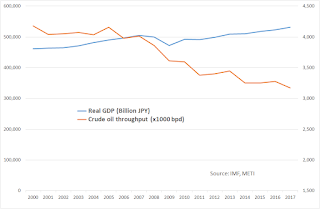Crude oil prices and petroleum demand in the U.S. have recovered pre-COVID-19 pandemic level. However, the recovery of crude oil production in the world's biggest producer is far delayed. What is the reason?
Crude oil production in the U.S. doubled during the 2010s due to the shale revolution. It reached 13 million barrels per day level as of pre-COVID crisis end-2019. Then the global loss of demand led the output level to below 10 million bpd and the current level is about 11 million bpd. Production in end-2022 is expected to be only 1.2 million bpd higher than end-2020 despite petroleum demand is seen to grow 1.9 million bpd in the same period.
Meanwhile, current crude oil prices are at the highest level since 2014 as supported by anticipated demand recovery and a solid alliance of OPEC+ nations. This price increase has led active oil rig count to above 400 in shale-producing regions in the U.S. It is doubled from a year ago when the COVOD-19 crisis damaged seriously, but 45% lower than the same period in 2019. Usually, rig count tracks crude oil prices with a 2-3 months delay as drilling needs such readiness period. However, we know that crude oil prices had already recovered to the 2019 level in early 2021.
Then,
let's look at another factor. It was natural that rig count dropped
significantly in the first half of last year due to the pandemic, but the
number of active rigs has started decreasing gradually in early 2019 before
that. Because, West Texas Intermediate, the benchmark crude price in the U.S.
dipped from about $70 per barrel to below $60/bbl. There are some different
ideas about the break-even point for crude oil production and it should vary
among regions. But a survey conducted by Dallas Federal Reserve Bank shows
about $30/bbl for existing wells (except for Eagle Ford where shows below $20
costs), and around $50/bbl for new wells are replied from exploration and
production firms. In other areas than Permian and Eagle Ford, break-even for
new shale oil wells is seen at $58/bbl.
Since the production and exploration costs are not changed significantly in the past few years, motivation for development is most likely to fade if prices decline below $60/bbl.
Capital
expenditure Index by exploration and production firms started decreasing from
Q4 2018 when the expected year-end crude oil price was lower than $60/bbl, then
recorded zero growth for the current quarter and negative growth for the next
year in Q3 2019. In 2020, a more serious situation forced many firms including large
entities to file bankruptcy.
Forecast for year-end price recovered $60/bbl again in Q1 2021 and Capital expenditures became positive for both the current quarter and the next year. Although the expenditure index is even higher in Q2 2021 as the expected year-end price is higher, it is still not enough to recover from the slump in 2020. Even though, capital expenditures are likely to expand, as firms have high motivation with over $70/bbl crude oil prices unless demand fears could depress prices.
Despite such expectations, production is not anticipated to update the historical level by accelerating the speed of recovery. The growth of crude oil output in 2021 is forecasted at only 300,000 bpd. It is because of the slow recovery of rig count as well as a sharp decrease in the number of drilled but uncompleted (DUC) wells.
DUC
means the wells drilled but waiting for completion of the fracking and other works. The
completion usually takes 2 months period and a lot of costs. Typically, when
developing shale wells, 35% of costs are used for drilling and 65% are spent
for completion.
Since late 2018 when investments slowed down due to unclear price expectations, the number of completed wells that can start production soon decreased but DUC increased in contrast. DUC is usually created to wait for favorable market conditions or to extend the leasing contract for the mining area. However, more than 8,000 DUC wells versus about 1,250 completed wells were an extraordinary situation.
As DUC wells are typically not maintained for more than 2 years, sharply increased DUC wells in late 2018 have started decreasing with high speed in late 2020. Since the number of completed wells is increasing slowly, most DUC wells are likely to be abandoned. Although the balance of wells' number may be becoming healthy, it is not a hopeful situation. Many firms are forecasting that both start production and keep waiting for the favorable market are not continually profitable solutions.
The crude oil market is fluctuating by unclear demand expectations based on
contrary factors of spreading corona variants and expanding vaccination.
Although price and demand may recover relatively faster, supply that needs
capital expenditure can't retrieve the ordinary situation in 1-2 years.





















